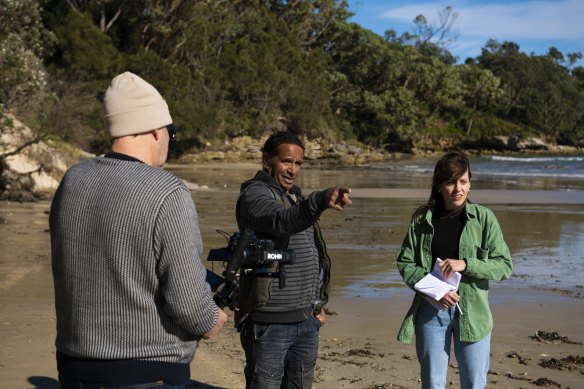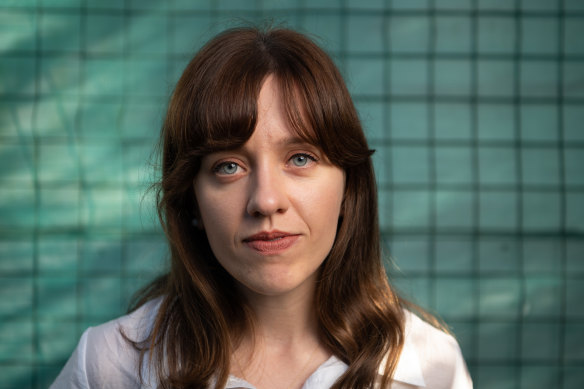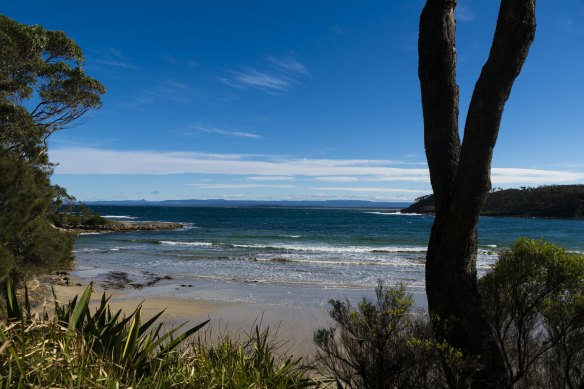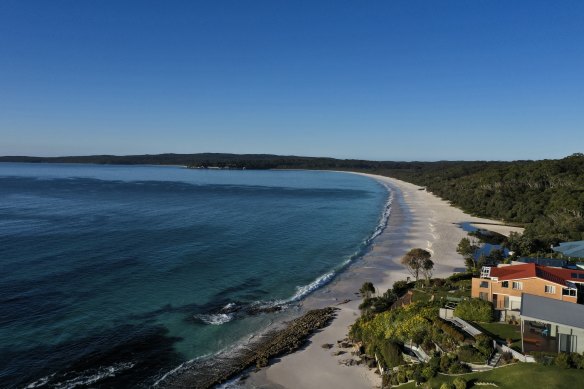This was published 1 year ago
How investigative reporter Carrie Fellner broke the Wreck Bay story
Mary Creek, Wreck Bay.Credit: IKANDY FILMS
Aboriginal and Torres Strait Islander readers are advised that the articles this Q&A links to contain the names and images of people who are deceased.
Good investigative journalism takes time and a hell of a lot of patience. I usually have very little of the latter, but understand that the best stories sometimes take months or even years to tell.
A new investigation by Carrie Fellner, an exceptional journalist at the Herald, typifies this approach. Her series, Poisoned Paradise, is the product of two years’ worth of sheer persistence and determination.
Poisoned Paradise tells the disturbing story of Wreck Bay, an Indigenous village in the NSW South Coast tourist mecca of Jervis Bay. Carrie’s investigation has revealed devastating sickness and death in the village, which happens to be located next to a Department of Defence base that used toxic firefighting foam for decades. The chemicals, called Per- and Polyfluorinated Substances, but more commonly known as PFAS, have been seeping into the community’s waterways, food supply and sacred sites, with catastrophic consequences.

Uncle Nick Carter with Herald journalist Carrie Fellner, filming a scene for the upcoming Stan documentary on Wreck Bay.Credit: Rhett Wyman
There are two key reasons why this investigation has been two-years in the making. The first is that Carrie has worked incredibly hard to earn the trust of community members to tell their story. As Carrie writes below, progress was painstaking, particularly in the early stages. So-called “fly in, fly out” journalism - in which we pursue the story whether the community likes it or not - would have been the absolute worst approach to take. I also want to acknowledge the work of Rhett Wyman, a Palawa man and Herald photographer who also worked so sensitively with the community, and my predecessor Lisa Davies.
The other factor behind the investigation’s long lead time is that it will feature in an upcoming documentary by iKandy Films, directed by Katrina McGowan and produced by Janine Hosking, Katrina McGowan and Mat Cornwell. It is supported by Ian Darling’s Shark Island Foundation, Screen Australia and Screen NSW. This form of storytelling is new terrain for the Herald and has been fascinating to watch develop.
Today, I am asking Carrie five questions about the investigation to give you a behind-the-scenes glimpse into the story.
Bevan Shields: What are PFAS?
Carrie Fellner: These man-made chemicals were invented by accident in the 1940s when scientists discovered they could create one of the strongest bonds known to humankind by combining carbon and fluorine. The chemicals were coveted by industry because they could repel grease, oil and water. They were first used in Scotchgard fabric protector and Teflon frying pans but today there’s not a corner of the earth that’s untouched by them. They are in the blood of all Australians, household products like makeup and food packaging to the polar bears in the Arctic and snow on the top of Mount Everest.
The chemicals persist for years in the environment and the human body - which is of growing concern as international health authorities sound the alarm about a slew of health effects that may be associated with exposure.

PFAS “persist for years in the environment and the human body, which is of growing concern”, says the Herald’s investigative reporter Carrie Fellner.Credit: Flavio Brancaleone/SMH
BS: When did you start looking into forever chemicals?
CF: I started investigating PFAS in 2015 when I was early in my journalism career at a small commercial radio station in Newcastle. I was at the first community meetings where Defence disclosed that its firefighting foam containing PFAS had contaminated homes surrounding the Williamtown RAAF Base.
At that time the chemicals were virtually unheard of in Australia so I seized the opportunity to learn as much as I could from international sources and relay the information back to the community, who had been left stunned and bewildered by Defence’s disclosures. I followed the story, and it followed me from job to job: a posting at The Newcastle Herald allowed me to do my first deep dives on the scandal, including a six-month investigation where I went door to door on the most polluted street in Williamtown and discovered 50 cases of cancer.
Most people seem to be unaware of the volume of PFAS they absorb from household products in their day-to-day lives.
Carrie Fellner
Around the time I joined The Sydney Morning Herald in early 2018, the Minnesota government had just settled the first major lawsuit against manufacturer 3M over contamination from PFAS. I managed to be the first to get my hands on the trove of 3M’s corporate documents unearthed during discovery and discovered astonishing evidence of a global campaign by 3M to deceive the public about the health effects of PFAS. When I travelled to Minnesota to investigate further, I uncovered 21 cases of cancer at a school next door to 3M’s global headquarters where the kids had been drinking contaminated water.

Carrie Fellner began investigating PFAS in Wreck Bay (Back Beach above) two years ago.Credit: Rhett Wyman
BS: When did you start investigating PFAS contamination at Wreck Bay?
CF: In 2021 I began the next leg of my investigations when I was contacted by Katrina McGowan and Janine Hosking, documentary makers who were interested in a class action launched by the Aboriginal community of Wreck Bay against the Commonwealth for cultural loss caused by PFAS contamination.
We joined forces and set out to do a story focused on how PFAS had put the community’s ancient cultural traditions in jeopardy. As time went on, it became clear there was also a story to be told about the devastating levels of ill health in Wreck Bay.
Progress was painstaking, particularly in the early stages. It took two years to forge connections with dozens of community members, sift through hundreds of buried government documents, lodge freedom of information requests with multiple government departments and track down health workers who could offer an outside opinion on the community’s health.

Idyllic Hyams Beach, just minutes from Wreck Bay.Credit: Rhett Wyman / SMH
But due to the sensitive nature of the material and what was at stake for the community, we couldn’t rush any stage of the process. We were cognisant we didn’t want to pressure people to go on camera: instead we waited for people to tell their stories in their own time.
The project was also a baptism of fire for a print journalist who had never been in front of the camera before. I’ve been told there’s a very long bloopers reel.
BS: Where to from here?
CF: The coverage on PFAS in Australia has very much focused on Defence’s use of firefighting foam, probably by virtue of the fact the organisation was the first to disclose contamination at its sites. However, the magnitude of the problem is so much greater than what’s in the public consciousness: firefighting foam has also contaminated dozens of sites belonging to fire brigades and private industry and most people seem to be unaware of the volume of PFAS they absorb from household products in their day-to-day lives.
I am hoping to see the science also evolve further so we see more independent, large scale epidemiological studies on populations exposed to PFAS and are not forced to rely on studies produced by private industry with vested interests.
Bevan Shields sends an exclusive newsletter to subscribers each week. Sign up to receive his Note from the Editor.